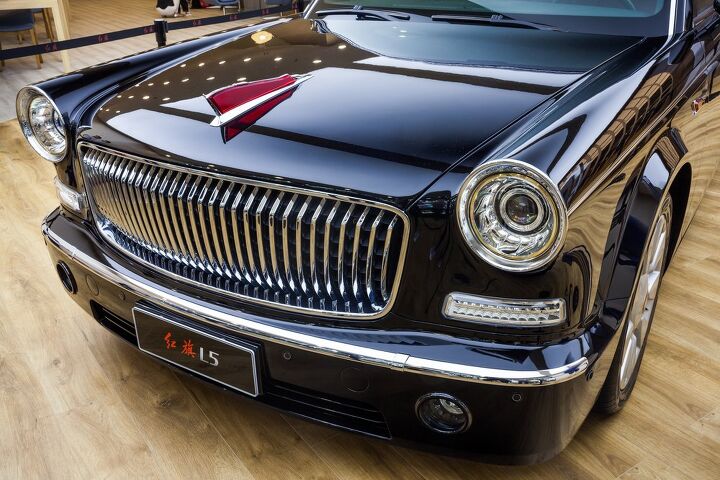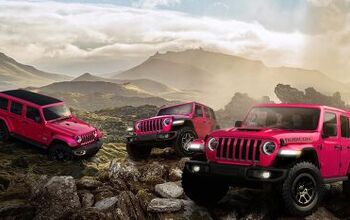Strange Bedfellows: American EV Company Partners With China's Hongqi

World leaders like to travel in comfort, security, and style — which is why you never see presidential motorcades formed around a Nissan Versa. Instead, security details crowd around something big, black, and closely tied to a domestic nameplate if the nation in question has such a manufacturer. In China, the preferred choice among high-ranking government officials has been FAW Group’s Hongqi luxury brand. Translated into English, the name means “Red Flag” and it’s the pride of China, even though the bulk of FAW’s premium models are a redux of various automotive products produced by foreign manufacturers.
That includes Hongqi’s first vehicle, the CA72. Launched in 1958 as a model exclusive to state institutions and the leadership of the Communist Party of China, the CA72 was basically a 1955 Chrysler sedan with a different grille. While that model line has had its own evolution, subsequent FAW products from the modern era benefited from joint partnerships with automakers like Mazda, General Motors, Toyota, and Audi.
A new joint venture specifically targeting Hongqi is now underway, and its a curious one. An American electric vehicle startup named SilkEV is apparently teaming up with the brand that symbolizes the CCP to produce high-end performance cars, and they’re spending a bundle to do so.
Considering Hongqi is known for manufacturing luxury products, zippy EVs are a step out of its comfort zone. However, Reuters reports the duo plans to invest 10 billion yuan ($1.41 billion USD) to make electric sports cars under the Red Flag marquee:
Silk EV on Monday told Reuters it has signed a memorandum of understanding with FAW to launch a joint venture in the state-owned automaker’s hometown of Changchun, northern China, to make cars it has dubbed the S-series.
The plan was first reported on Friday by state media CCTV and Xinhua. FAW confirmed the CCTV report to Reuters.
S-series, eh? Sounds like Hongqi’s habit of borrowing from other nameplates hasn’t abated. But at least it’s getting more creative. Besides, there are plenty of non-Chinese automakers that have been trying to parody the German way of doing things for years (cough, Cadillac) instead of evolving their existing modus operandi.
While Silk EV’s status as an LLC officially makes it an American company based in New York City, it has offices in China and Italy, with the brunt of its engineering and design work focused on the former market. What that all entails remains hazy. Its website describes it as complete auto solutions provider (provided they’re electric) with “an elite team of engineers.” No examples were provided for either, and this is the first we’ve heard of the firm.
Cursory research shows Silk’s head of U.S. operations, Justin Krane, previously worked as legal council for Trella Urban Forestry Technology LLC (where he’s still employed). He was also quoted in a press release last year when Acorn International promoted the company in China. Other than the address for his law office matching the address given for the automotive business, that’s about all we’re likely to learn until Silk EV responds for comment.
Meanwhile, Chinese state media says FAW plans to broaden Hongqi appeal and double its annual sales to 200,000 units by the end of 2020. While the pandemic may upend those plans for growth, the overall strategy involves increasing its lineup of 10 models to 21 by 2025.
The first product Silk EV is likely to lay its hands on is the Hongqi S9 (below) — a 1,400 hp hypercar that debuted (in concept form) at the 2019 Frankfurt Motor Show and looks a bit like the McLaren Senna. FAW Group chairman Xu Liuping said the S9 will be capable of 62 mph in under 2 seconds thanks to its “V8T hybrid power system” (presumably a turbocharged V8 helped by small electric motors). The car is also supposed to boast a top speed of 250 mph, a maximum range of 373 miles, all while still being incredibly comfortable, sharp, and a bunch of other stuff that makes it sound too good to be true.
[Images: VanderWolf Images/Shutterstock; moonfish8/Shutterstock]

A staunch consumer advocate tracking industry trends and regulation. Before joining TTAC, Matt spent a decade working for marketing and research firms based in NYC. Clients included several of the world’s largest automakers, global tire brands, and aftermarket part suppliers. Dissatisfied with the corporate world and resentful of having to wear suits everyday, he pivoted to writing about cars. Since then, that man has become an ardent supporter of the right-to-repair movement, been interviewed on the auto industry by national radio broadcasts, driven more rental cars than anyone ever should, participated in amateur rallying events, and received the requisite minimum training as sanctioned by the SCCA. Handy with a wrench, Matt grew up surrounded by Detroit auto workers and managed to get a pizza delivery job before he was legally eligible. He later found himself driving box trucks through Manhattan, guaranteeing future sympathy for actual truckers. He continues to conduct research pertaining to the automotive sector as an independent contractor and has since moved back to his native Michigan, closer to where the cars are born. A contrarian, Matt claims to prefer understeer — stating that front and all-wheel drive vehicles cater best to his driving style.
More by Matt Posky
Latest Car Reviews
Read moreLatest Product Reviews
Read moreRecent Comments
- SCE to AUX This was the same car I had (05 xB, stick, "camouflage" color) for 7 years - great car.We called ours "The Lunchbox". I added aftermarket wheels, and the 3rd-party cruise control the dealers could install.It suffered only two failures: bad window switch in week 2 (dealer fixed in 1 hour), bad trailing O2 sensor (fixed myself for $70). Fuel economy was always 28-34 mpg.It was a potential death trap, and ride quality became unbearable after 2 hours. I once did a 10-hour round trip in it and could barely walk after.Traded it for a 2012 Leaf, which was a better car in some ways.
- Bd2 The "e" nomenclature signifies the e-ATPs which BMW is pursuing.
- Dave M. I'm sorry to see any storied name go away. The lifespan of the Malibu has fit perfectly in my lifetime years-wise. Some of the highlights include the first and second generations, the '78 revamp (very clean design), and the 2005 generation. Ford, GM and Mopar gave this segment away by allowing Toyota and Honda a foot in the door and then always having to play catch-up. How hard is it to make a truly competitive sedan at a profit? Obviously, Japan Inc. figured it out.I've driven a few rentals these past years; the Malibu got the job done but honestly the Passat and Altima were my rental preferences.
- Kcflyer actually yes. It's a shame that a product this uncompetitive can still outsell GM's entire EV offerings. Those products have had billions thrown at them. Imagine how nice the new Malibu, Impala, SS, and Lacrosse would be with that kind of commitment.
- 3SpeedAutomatic Nope....



































Comments
Join the conversation
Roads are not "set aside for motor vehicle use." Neither legally nor in practice. Horses, mopeds, unicycles, skateboards, scooters, whatever you've got is legal on the road in my state, except on limited access highways. If you're a driving enthusiast, other modes and their users are not your enemy. Who's slowing you down? Is it the guy on the scooter? The ped crossing at the light? Or is it the endless sea of Camry and Odyssey drivers dawdling along, bored, half looking at their phones? Isn't that the biggest difference between real-world driving and the winding open road in the car commercials?
This is the only 1/2 decent looking new car I've seen in years . Thanx for the comments all ! =8-) . -Nate